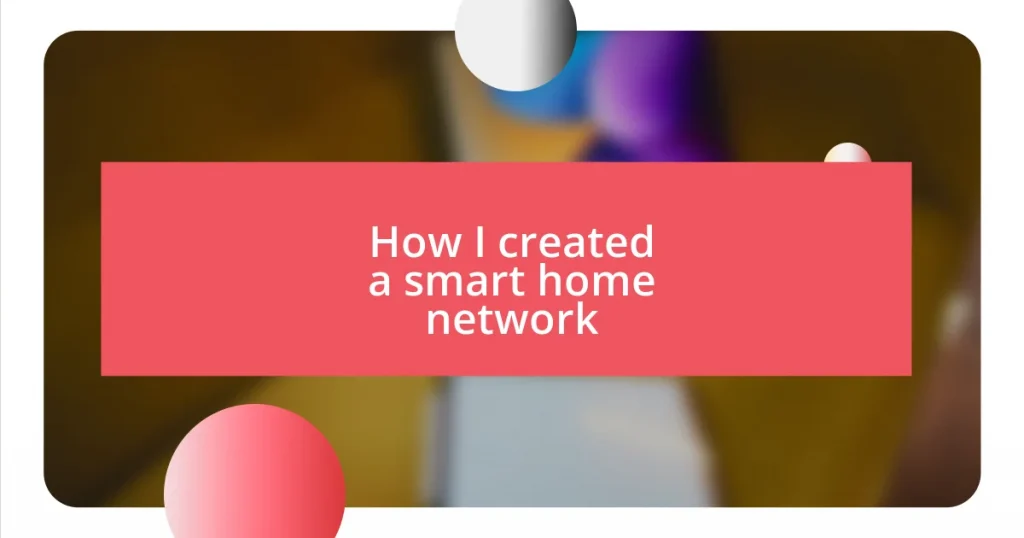Key takeaways:
- Choosing compatible devices and investing in a quality router are crucial for an effective smart home network.
- Security measures, such as strong Wi-Fi passwords and regular firmware updates, are essential for protecting smart devices.
- Expanding a smart home network involves balancing convenience with performance and creating an integrated ecosystem for seamless functionality.
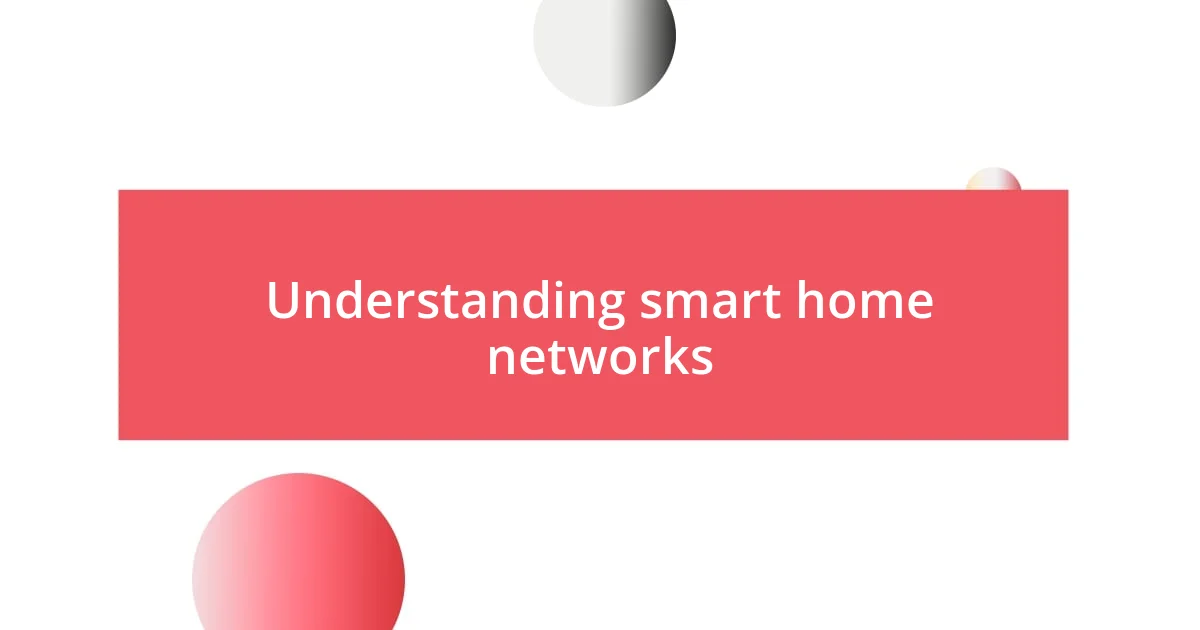
Understanding smart home networks
Smart home networks involve connecting various devices in your home, allowing them to communicate and work together seamlessly. I remember the first time I integrated my smart thermostat with my security system; it dawned on me how these devices could enhance not just convenience, but safety as well. Have you ever thought about how interconnected your home could actually be, and what that means for your daily life?
At their core, these networks often utilize Wi-Fi or Bluetooth technology to enable communication between your devices. I still feel a rush of excitement every time I say, “Hey, Google, turn off the lights!” and watch as the entire room goes dark with just my voice. It’s exactly this level of control and automation that transforms a simple house into a smart home, making life not just easier, but also a bit more magical.
Understanding the foundational components, like the role of hubs and protocols, is essential for anyone looking to dive into smart home technology. When I was first starting, the abundance of choices seemed overwhelming, yet I found that familiarizing myself with these technical terms allowed me to make informed decisions. Isn’t it amazing how once you break it down, the potential of creating a smart home networks opens doors to creativity and personalization?

Choosing the right equipment
When it comes to choosing the right equipment for your smart home network, you can’t overlook the importance of compatibility. I recall an instance where I impulsively bought a top-rated smart bulb without verifying if it would work with my existing hub. I ended up wasting time and money. How frustrating! Now, I always ensure that any device I consider is compatible with my central hub—this is crucial for a seamless experience.
Another critical factor is the range and speed of your Wi-Fi network. I once underestimated how many devices I would add to my network, and before I knew it, my connection slowed down significantly during peak usage times. By investing in a quality router with good coverage and speed, I’ve found that my devices respond almost instantly, which is a game-changer for day-to-day functionality.
Finally, consider the security features of your devices. In my early days of building a smart home, I didn’t prioritize security much and left my devices vulnerable to potential breaches. Learning about encryption and secure connections has been eye-opening. Trust me, having reliable security measures gives you peace of mind while you enjoy the conveniences of your smart home.
| Device | Compatibility |
|---|---|
| Smart Bulb | Must match hub platform (e.g., Zigbee, Z-Wave) |
| Router | Wi-Fi 6 recommended for speed |
| Smart Lock | Check compatibility with security systems |
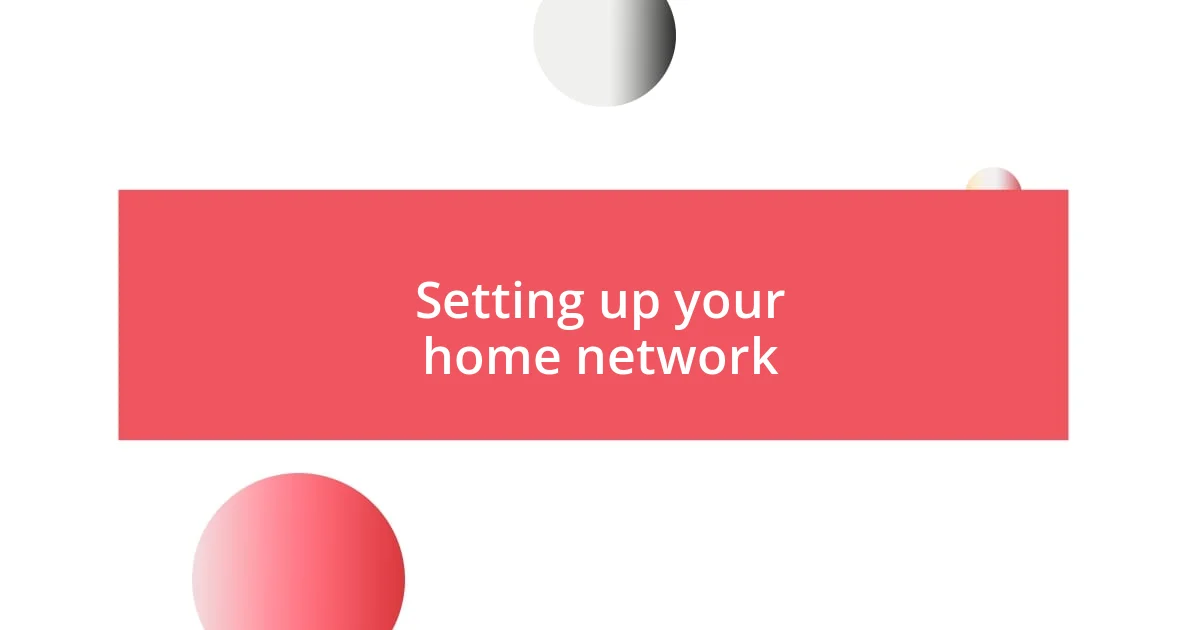
Setting up your home network
Setting up your home network is a crucial step in creating a fully functional smart environment. I remember feeling both excited and a bit nervous when I took the plunge to set up my first network. The first thing I did was assess my space and determine the optimal location for my router to ensure strong Wi-Fi coverage throughout the house. There’s nothing more frustrating than buffering when you’re trying to enjoy your favorite playlists or streaming shows!
Here are a few steps I found valuable when setting up my home network:
- Choose the Right Location for Your Router: The center point of your home typically offers the best coverage.
- Implement a Mesh Network if Needed: For larger spaces, a mesh network can eliminate dead zones and ensure seamless connectivity.
- Secure Your Network: Always set a strong Wi-Fi password to keep unauthorized users out.
- Name Your Network Thoughtfully: I like to personalize mine; it adds a bit of fun every time I connect a new device.
As I configured my devices, I also learned the importance of organizing them within categories, making management easier down the line. It’s like creating your digital neighborhood—knowing where everything belongs facilitates quicker access and control. I vividly remember the little thrill of seeing all my devices light up and respond in harmony for the first time. It truly felt like magic coming to life!
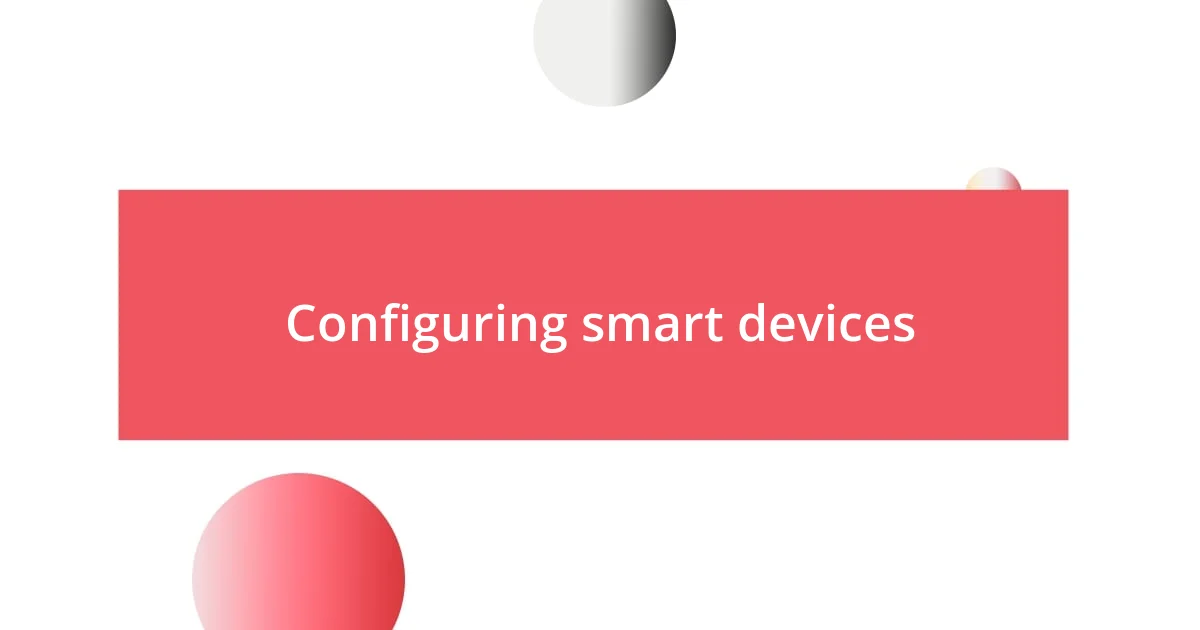
Configuring smart devices
Configuring smart devices can feel like a daunting task at first. However, I found that taking a methodical approach really helps. For instance, when I unpacked my first smart thermostat, instead of diving right in, I carefully read the manual to understand its specific requirements and features. Having that foundational knowledge made all the difference and prevented a lot of potential headaches.
As I began to sync my devices, I realized that connecting each device to the central hub can be a bit like solving a puzzle. I remember my struggle with a smart speaker that just wouldn’t connect. After a few frustrating attempts, I took a step back and checked for firmware updates—I had been overlooking this key step. Once updated, the connection was seamless, and it felt incredible to command my speaker with just my voice!
With each device I configured, I felt more in control of my smart home. There’s something satisfying about organizing my devices into groups, like “Living Room” or “Kitchen.” I can easily manage everything from my smartphone, making life so much easier. Have you experienced that sense of accomplishment when everything works as intended? It’s a mix of excitement and relief that keeps me motivated to explore even more innovations in the smart home realm.
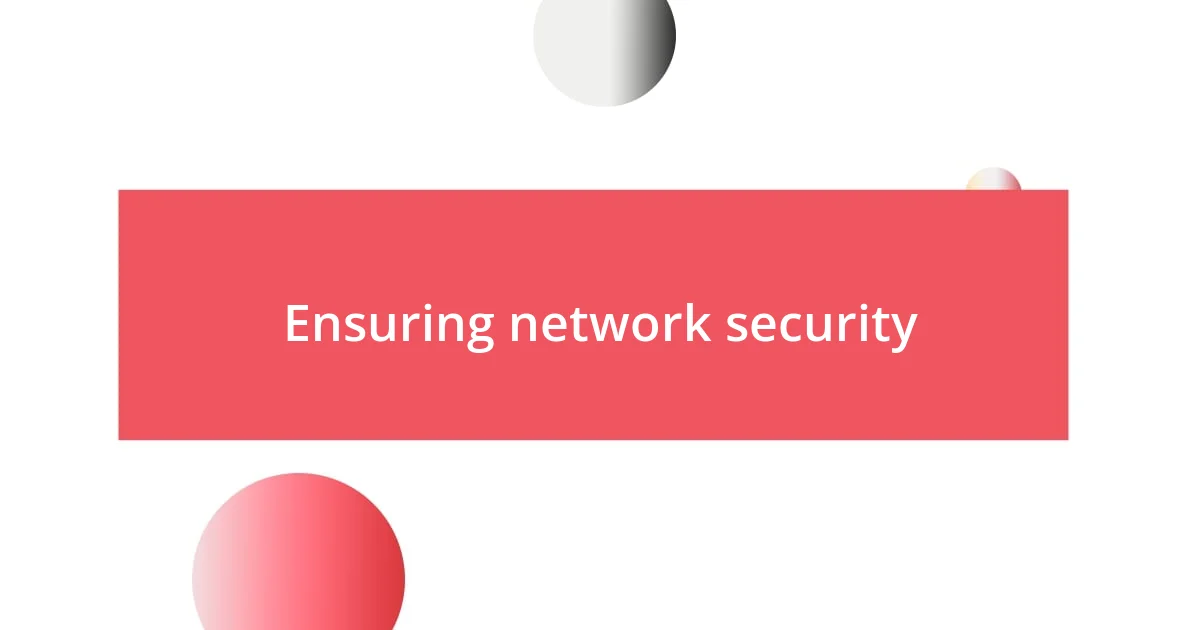
Ensuring network security
When it comes to ensuring network security, I can’t stress enough the importance of using a strong and unique Wi-Fi password. I distinctly remember the relief that washed over me when I realized my network was invisible to unwelcome eyes simply by implementing this step. It’s kind of like locking the front door—something so simple yet so crucial in safeguarding my digital space.
Another tactic I adopted was enabling network encryption, specifically WPA3 when available. The first time I toggled this setting, I felt a sense of empowerment knowing that my data was now encoded and much harder for snoopers to intercept. A little technical jargon can go a long way in enhancing our security—it’s worth familiarizing yourself with terms like encryption, as they are vital in fortifying your smart home network.
I also learned the hard way that keeping my devices updated is paramount. On one occasion, I neglected a firmware update on my smart camera, only to discover later that it had vulnerabilities. That moment was a vivid reminder of why I need to check for updates regularly. Have you ever faced a setback like that? It’s an uncomfortable lesson but one that has solidified my commitment to proactive network maintenance and security awareness.

Troubleshooting common issues
Sometimes, the biggest hurdles arise when devices lose connectivity. I still remember the helpless feeling when my smart light bulbs suddenly stopped responding to commands. After some investigation, I discovered that my Wi-Fi router had simply restarted. Restarting the router solved the problem, but it made me realize how essential it is to have a stable Wi-Fi signal for all my devices.
Occasionally, I’ve faced compatibility issues when adding new devices. I fondly recall the excitement of getting a new smart doorbell, only to find it wasn’t compatible with my current system. Instead of giving up, I dove into online forums and user reviews—what a wealth of information! I eventually found a compatible hub that worked, and that challenge turned into a learning opportunity. Have you ever faced compatibility struggles? They can be frustrating, but finding solutions can really bolster your confidence.
Lastly, I’ve run into situations where I would try to control my devices remotely, yet they wouldn’t respond. This happened during a family gathering when I attempted to show off my smart blinds. I quickly realized my app hadn’t updated recently, which caused the hiccup. I’ve learned to regularly check for app updates and, frankly, it has saved me from a lot of embarrassment. Keeping apps in sync can prevent these jarring moments—how do you make sure your tech stays updated? Sharing tips with friends is something I do often, and finding solutions can feel like a team victory.
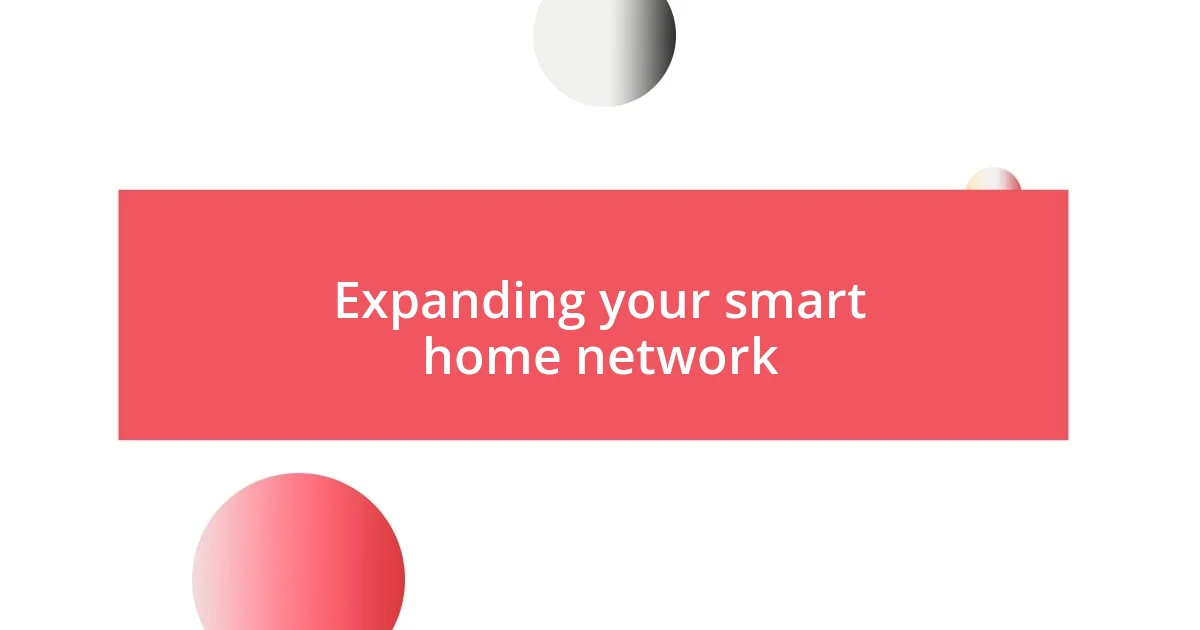
Expanding your smart home network
Expanding my smart home network was truly an eye-opening experience. I remember the day I decided to add smart locks to my front door; the thought of controlling the entry points to my home from my phone filled me with excitement. But as I added more devices, I soon realized that I had to maintain a careful balance between convenience and performance. Have you ever felt that initial thrill of automation, only to worry about whether your network could handle it all? I did, and it led me to double-check my router’s specifications and ensure that it could support multiple connections without lag.
One of the best decisions I made was investing in a mesh Wi-Fi system. The moment I installed those extra nodes, I felt an incredible difference in the connectivity throughout my home. Suddenly, my far-flung smart devices were as responsive as those sitting right next to the router. I still get a rush of satisfaction when I hear the door lock engage or the lights dim just by pushing a button on my phone. But what if you’re unsure about upgrading your router? I suggest doing a little research on your specific needs, as it might just turn your frustrations into smooth sailing.
I’ve also learned that expanding isn’t only about adding more gadgets—it’s also about creating a cohesive ecosystem. When I integrated my smart speakers with the rest of my devices, everything became effortless. I remember one evening when I casually asked my speaker to dim the lights and play my favorite playlist. It felt like I had my own personal assistant. Have you transitioned from simple devices to a fully integrated smart home? That journey can be both enlightening and gratifying as your space adapts to your lifestyle.










